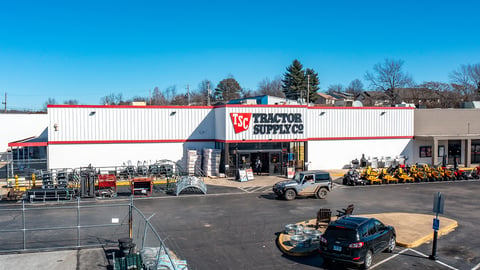EXCLUSIVE Q&A: Tractor Supply Company talks supply chain, AI, tariffs — and more
Tractor Supply Company is scaling and enhancing its use of supply chain automation as it embarks on an aggressive growth strategy.
Chain Store Age recently spoke with Colin Yankee, chief supply chain officer of Tractor Supply Company, about how the nation’s largest rural lifestyle retailer is leveraging artificial intelligence and automation in its supply chain to support an ambitious growth target of operating 3,200 stores across the country by 2030.
Yankee gave some specific insights into the high-tech distribution center Tractor Supply Company is building in Nampa, Idaho, as well as its strategy to minimize the impact of tariffs and his thoughts on how AI will unfold in the retail supply chain in the next 12 months.
Why is Tractor Supply Company opening a new distribution center?
We are operating 10 distribution centers across the country and have a gap up in the Pacific Northwest. The new facility in Nampa, Idaho will allow us to serve the Pacific Northwest.
[READ MORE: Tractor Supply Company breaks ground on Idaho supply chain hub]
Stores in Washington, Oregon, California, Idaho and Nevada are serviced from either Arizona or Nebraska. Putting this new distribution center in Idaho will significantly improve our expenses, cut down our lead time, shift our vendor base further to the west, and help us with efficiency and servicing our customers much faster.
Also, we continue to open new stores and are looking to grow from 2,400 to 3,200 stores. This gives us some expansion opportunity in the Pacific Northwest as well.
How do automation and artificial intelligence fit into the Tractor Supply Company supply chain strategy?
I'll start by breaking automation into two different buckets - physical and systems automation. On the physical side, we are investing heavily into designing robotics for our distribution centers that that help us move our type of products.
For example, we sell a lot of bagged food and feed, so automating that process is very important. The new Idaho facility has a sophisticated goods-to-person system that's going to house over 50% of the items we store in the distribution center and improves our productivity by about 14%.
On the systems side, we take an enterprise view of AI applications. Our biggest applications are tracking inventory forecasting and scenario planning across our entire network. Tractor Supply Company is applying machine learning and AI to positioning inventory.
We operate very small stores, so it's important for us to be agile with our inventory, as well as the scenario planning around that through our forecasting replenishment system. Just now, we are starting to get into applying large language models for interpreting data from the early stages of using agentic AI.
Can you give more details of how Tractor Supply Company uses agentic AI?
We have an enterprise license with a major AI provider and are sharing that across the company. In addition, we are expanding the user base and allowing them to use the large language model which is deployed over our data sets today to query it and build GPT models on top of it.
How is Tractor Supply Company mitigating the impact of tariffs?
About 45% of the finished goods we purchase are made from products that are manufactured, bagged, assembled or grown in the U.S. That includes items like dog food, animal feed, greases and lubricants, and represents a large portion of our product purchases.
Eight percent of finished goods we purchase come from products that we directly import. For those direct imports, we have been steadily developing a lot of new sources and reducing our footprint out of China for years.
Eight years ago, a majority of that directly imported product was now China. But even prior to the tariff announcements, we were on plan have that be less than 50% By the end of 2025, only a small portion of the product we directly import will be from China.
The remaining 47% of the goods we purchase domestically may be imported from a vendor or have component parts are sourced from all over the world. We have very clear line of sight on the materials that make up those products, meaning how much of a finished good is made from imported components.
That allows us to have conversations with our suppliers about their cost of inventory and how their sourcing impacts our pricing. In addition, we use a ‘first sale’ program for our products that we import, which allows us to use the lowest price out of all the transactions involved in importation to determine the cost that we're paying on the tariff rate.
What do you think the biggest retail supply chain trend will be during the next 12 months?
I think the biggest game changer is AI. We are already seeing it in the hands of operators being democratized, being applied in practical use cases, and seeing the outputs of it. AI usage in the supply chain is accelerating as our users get more efficient with engineering prompts and designing the APIs.
There has already been acceleration of AI usage in forecasting and labor planning and task management and upstream optimization of order management. I think it's really going to change how we do everything at Tractor Supply Company, from routing and scheduling of our last mile deliveries to space planning in our stores.




